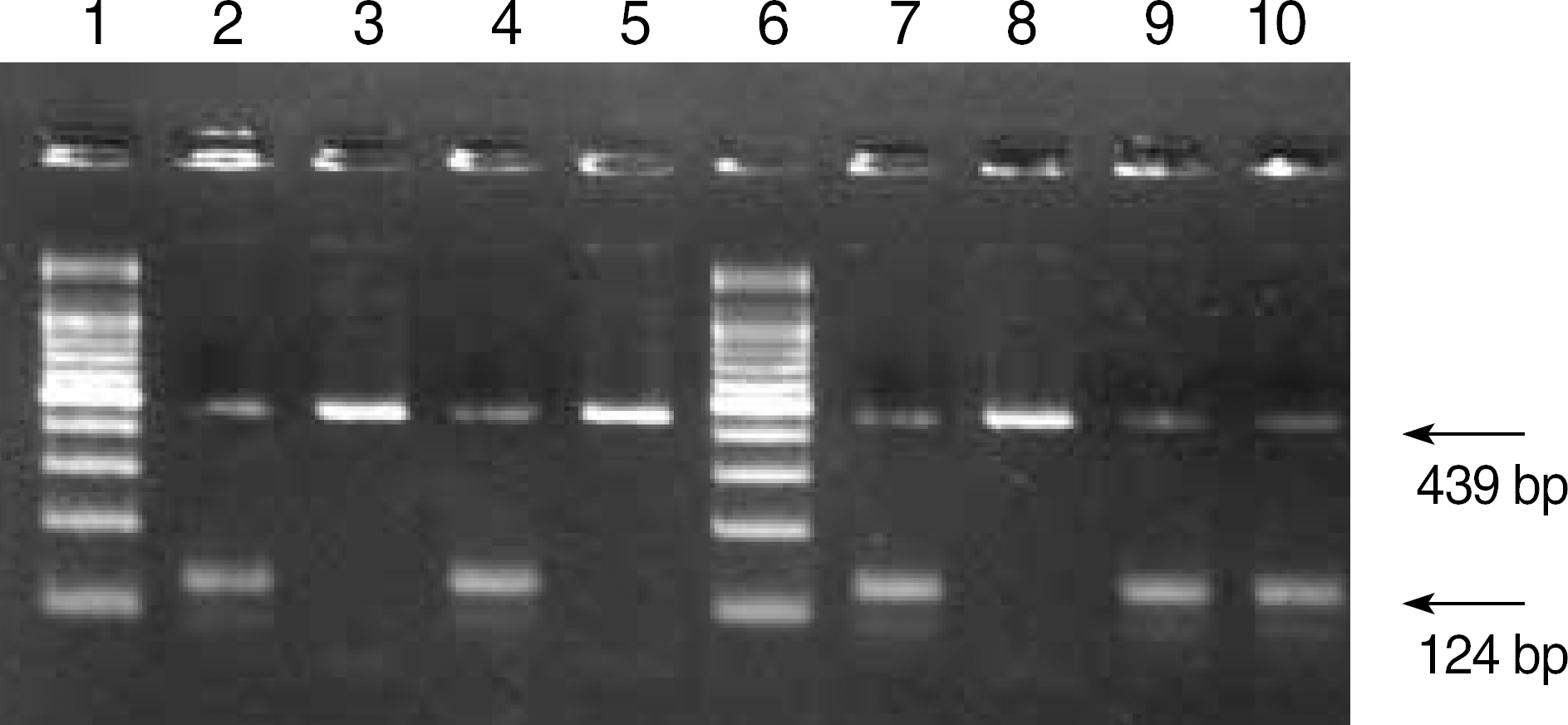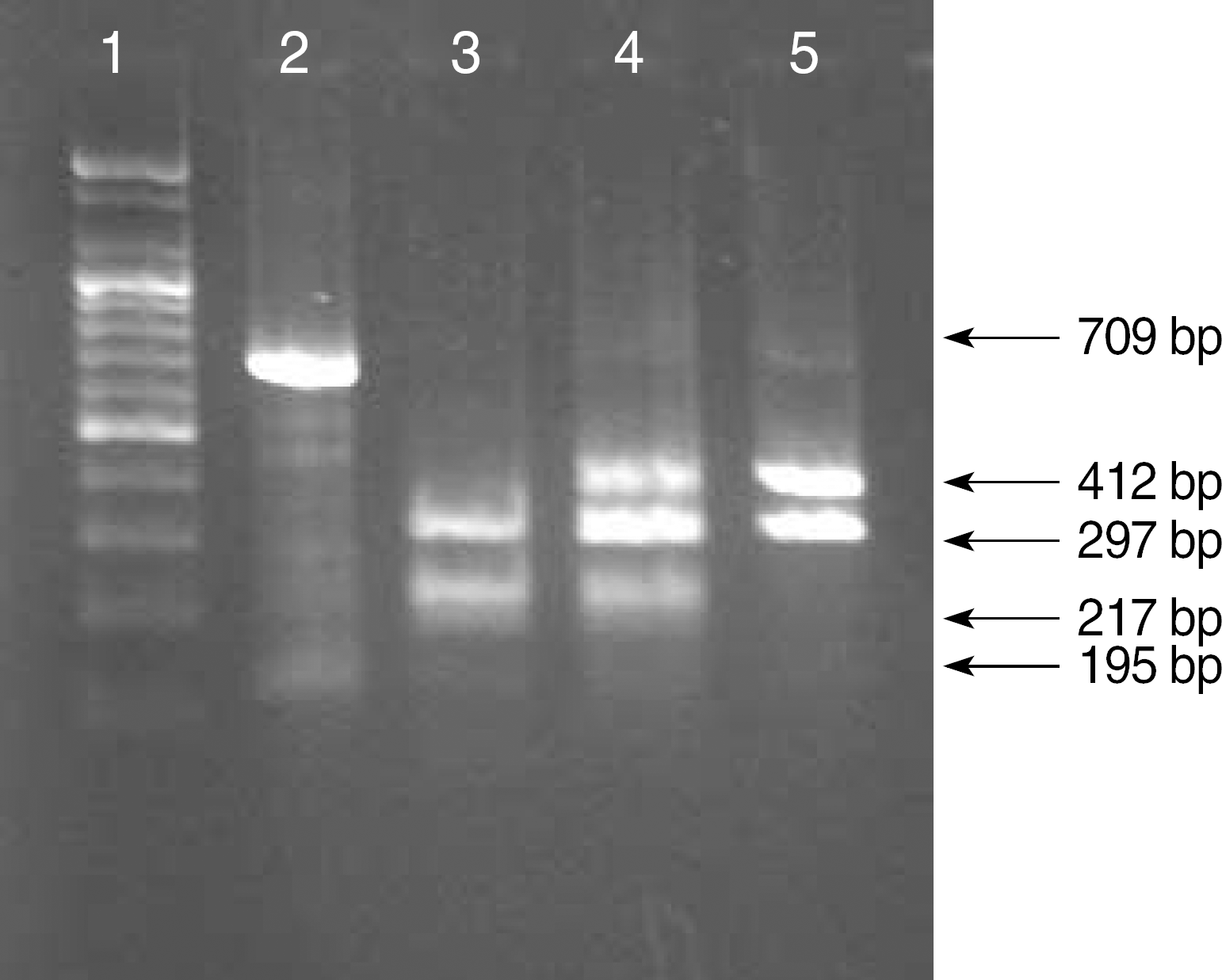Abstract
Background
In Korean population, antigen frequencies of HNA-1a, HNA-1b, and HNA-2a are determined using a serological and genotyping method. However, no study has been done to assess the gene frequencies of HNA-4a and HNA-5a. It has been reported that the antibody against HNA-4a is associated with alloimmune neutropenia and autoimune neutropenia; however, there is no confirmed clinical report on anti-HNA-5a-related disorders. The aim of this study was to determine HNA-4a and HNA-5a gene frequencies among the Korean population.
Methods
Genotyping of HNA-4a and HNA-5a genes of 110 healthy and unrelated Korean donors was performed using a polymerase chain reaction with sequence-specific primers and an allele-specific restriction enzyme analysis.
References
1. Lalezari P, Radel E. Neutrophil-specific antigens: immunology and clinical significance. Semin Hematol. 1974; 11:281–90.
2. Bux J. Molecular nature of granulocyte antigens. Transfus Clin Biol. 2001; 8:242–7.
3. Stroncek D. Granulocyte antigens and antibody detection. Vox Sang. 2004; 87:91–4.
4. Fung YL, Pitcher LA, Willett JE, Reed C, Mison L, Bux J, et al. Alloimmune neonatal neutropenia linked to anti-HNA-4a. Transfus Med. 2003; 13:49–52.

5. Simsek S, van der Schoot CE, Daams M, Huiskes E, Clay M, McCullough J, et al. Molecular characterization of antigenic polymorphisms (Ond(a) and Mart(a)) of the beta 2 family recognized by human leukocyte alloantisera. Blood. 1996; 88:1350–8.

6. Clague HD, Fung YL, Minchinton RM. Human neutrophil antigen-4a gene frequencies in an Australian population, determined by a new polymerase chain reaction method using sequence-specific primers. Transfus Med. 2003; 13:149–52.

7. Hartman KR, Wright DG. Identification of autoantibodies specific for the neutrophil adhesion glycoproteins CD11b/CD18 in patients with autoimmune neutropenia. Blood. 1991; 78:1096–104.

8. Han KS, Um TH. Frequency of neutrophil-specific antigens among Koreans using the granulocyte indirect immunofluorescence test (GIFT). Immunohematology. 1997; 13:15–6.

9. Ohto H, Matsuo Y. Neutrophil-specific antigens and gene frequencies in Japanese. Transfusion. 1989; 29:654.

10. Lin M, Chen CC, Wang CL, Lee HL. Frequencies of neutrophil-specific antigens among Chinese in Taiwan. Vox Sang. 1994; 66:247.

11. Seo DH, Park SS, Han KS. Genotype analysis of granulocyte-specific antigens in Koreans. Korean J Clin Pathol. 1997; 17:1144–9.
12. Fujiwara K, Watanabe Y, Mitsunaga S, Oka T, Yamane A, Akaza T, et al. Determination of granulocyte-specific antigens on neutrophil FcA receptor IIIb by PCR-preferential homoduplex formation assay, and gene frequencies in the Japanese population. Vox Sang. 1999; 77:218–22.
13. Chu CC, Lee HL, Chu TW, Lin M. The use of genotyping to predict the phenotypes of human platelet antigens 1 through 5 and of neutrophil antigens in Taiwan. Transfusion. 2001; 41:1553–8.

14. Bux J. Nomenclature of granulocyte alloantigens. ISBT Working Party on Platelet and Granulocyte Serology, Granulocyte Antigen Working Party. International Society of Blood Transfusion. Transfusion. 1999; 39:662–3.
Fig. 1.
HNA-4a genotyping by PCR-SSP. Lanes 1 and 6 show a DNA ladder marker (Bioneer, Daejeon, Korea). The amplification products (439 bp) of the internal control (HGH gene) are present in each lane. Lanes 2, 3, 7, and 8 contain HNA-4a-positive-specific reactions. Lanes 4, 5, 9, and 10 contain HNA-4a-negative-specific reactions. Lanes 2 and 4 are positive controls for HNA-4a-positive and HNA-4a-negative samples, respectively, and lanes 3 and 5 are negative controls for HNA-4a-positive and HNA-4a-negative samples, respectively. Lanes 7 and 8 contain an HNA-4a-positive homozygote sample and lanes 9 and 10 contain an HNA-4a-heterozygote sample.

Fig. 2.
HNA-5a genotyping by Bsp1286I allele-specific restriction enzyme analysis (ASRA). Lane 1 shows a DNA ladder marker (Bioneer, Daejeon, Korea); lane 2 shows an undigested 709 bp PCR product of αL chain of β2 integrin cDNA; lane 3 shows an HNA-5a-positive homozygote sample (297 bp, 217 bp, and 195 bp); lane 4 shows an HNA-5a heterozygote sample (412 bp, 297 bp, 217 bp, and 195 bp); and lane 5 shows an HNA-5a-negative homozygote sample (412 bp, and 297 bp).

Table 1.
HNA-4a and HNA-5a genotype frequencies and gene frequencies
| HNA-4a | HNA-5a | ||
|---|---|---|---|
| Genotype frequencies | +/+ | 0.973 (107/110) | 0.927 (102/110) |
| +/- | 0.027 (3/110) | 0.064 (7/110) | |
| −/- | 0.000 (0/110) | 0.009 (1/110) | |
| Allele frequencies | + | 0.986 | 0.959 |
| − | 0.014 | 0.041 |
Table 2.
Reported human neutrophil antigen (HNA) gene frequencies
| HNA system | Korean | Chinese | Japanese | Caucasian | References |
|---|---|---|---|---|---|
| HNA-1a | 0.52 | 0.68 | 0.65 | 0.35 | 7–13 |
| HNA-1b | 0.48 | 0.32 | 0.35 | 0.65 | 7–13 |
| HNA-1c | nk | 0.0 | 0.0 | 0.02–0.03 | 7–13 |
| HNA-2a | 0.62 | 0.91 | 0.66 | 0.83 | 7–13 |
| HNA-3a | nk | nk | nk | 0.66 | 13 |
| HNA-4a | 0.99* | nk | nk | 0.91 | 5, 6, 13 |
| HNA-5a | 0.96* | nk | nk | 0.82 | 5, 13 |




 PDF
PDF ePub
ePub Citation
Citation Print
Print


 XML Download
XML Download